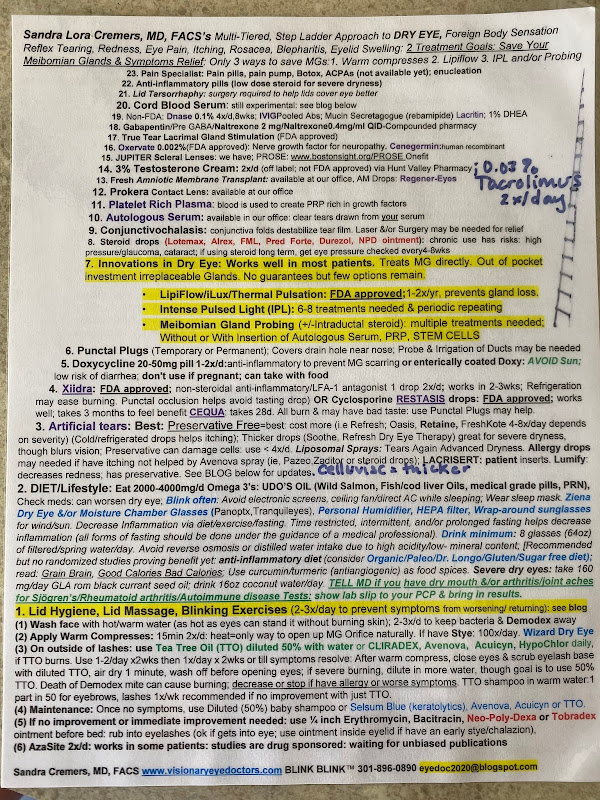Here is my most updated Step Ladder for Dry Eye.
We have had more success with Autologous Adipose-Derived Stem cells inserted into the Meibomian glands (before the Maskin cannulas were discontinued) and as drops and Cord blood serum drops.
Testosterone with our without Tacrolimus has also been helping but it is difficult to find compounding pharmacies to make these in certain areas of the US.
SLC
. 2012 Aug;31(8):945-9.
doi: 10.1097/ICO.0b013e31823f8c9b.
Clinical treatment of dry eye using 0.03% tacrolimus eye drops
- PMID: 22511024
- DOI: 10.1097/ICO.0b013e31823f8c9b
Abstract
Purpose: To report the clinical outcome of the treatment of dry eyes using 0.03% tacrolimus eye drops (olive oil + tacrolimus 0.03%) (Ophthalmos, Sao Paulo, Brazil).
Methods: Sixteen eyes of 8 patients with Sjögren syndrome dry eyes (age, 51.13 ± 9.45 years) were enrolled in this study (prospective noncontrolled interventional case series). Patients were instructed to use topical 0.03% tacrolimus eye drops twice a day (every 12 hours) in the lower conjunctival sac. Schirmer I test, break-up time, corneal fluorescein, and rose bengal staining score were performed in all patients 1 day before, and 14, 28, and 90 days after treatment with 0.03% tacrolimus eye drops.
Results: The average fluorescein staining and rose bengal staining scores improved statistically significantly after 14 days of treatment and improved even more after 28 and 90 days. The average Schirmer I test did not improve statistically significantly after 28 days of treatment, although we did observe a significant improvement after 90 days of treatment with 0.03% tacrolimus eye drops. The average break-up time did not improve statistically after 14 days of treatment, although we observed a significant improvement after 28 and 90 days of treatment with 0.03% tacrolimus eye drops.
Conclusions: Topical 0.03% tacrolimus eye drops successfully improved tear stability and ocular surface status in patients with dry eyes.
Comparing Effect of Topical Tacrolimus 0.03% Versus Cyclosporine 0.05% in Dry Eyes of Secondary Sjogren Syndrome
 |
The safety and scientific validity of this study is the responsibility of the study sponsor and investigators. Listing a study does not mean it has been evaluated by the U.S. Federal Government. Read our disclaimer for details. |
| ClinicalTrials.gov Identifier: NCT03865888 |
|
Recruitment Status : Completed
First Posted : March 7, 2019
Last Update Posted : May 22, 2019
|
- Study Details
- Tabular View
- Results Submitted
- Disclaimer
- How to Read a Study Record
| Condition or disease | Intervention/treatment | Phase |
|---|---|---|
| Dry EyeSjogren Syndrome | Drug: CyclosporinsDrug: Tacrolimus | Phase 3 |
Sjogren syndrome is a chronic autoimmune disorder characterized by immune cell infiltration of exocrine glands (exocrinopathy or epitheliitis) and systemic complications due to autoantibody production, immune complex deposition and lymphocytic infiltration of many organs .The loss of aqueous tear flow in Sjogren syndrome is a result of inflammatory cell infiltration of the lacrimal glands.The principal ocular manifestation of which is decreased tear production leading to chronic irritation and damage to the corneal and conjunctival epithelium. Dry eye associated with Sjogren syndrome (SS dry eye) is often more severe than non-Sjogren dry eye (non-SS dry eye). Rose bengal staining, fluorescein staining, impression cytology, and brush cytology show greater changes in SS dry eye owing to a lack of both basic tearing and reflex tearing resulting from lacrimal gland destruction, which is the hallmark of deteriorating clinical conditions.
The initial tear film ocular surface society dry eye workshop report noted the importance of ocular surface inflammation not only in the development of, but as a downstream effect and propagator of dry eye disease , and reviewed a range of therapies that function, at least in part, by anti-inflammatory mechanisms of action. Thus understanding the link between inflammation and dry eye validates the utilization of anti-inflammatory therapy in everyday practice.
Cyclosporine is understood to be an immunomodulatory drug with anti-inflammatory properties, as well as having other actions relevant to managing dry eye disease . Topical cyclosporine was approved by the FDA for the treatment of moderate-to-severe dry eye disease in 2003, based on an improvement in tear production.
Tacrolimus, a macrolide produced by Streptomyces tsukubaensis,was discovered in 1984 in Japan while searching for new immunosuppressive and cancer chemotherapeutic agents. The use of tacrolimus is of special interest in ophthalmology because it is indicated to be effective in the treatment of immune-mediated diseases Thus, the investigators performed this study to evaluate the effect of two different immunomodulatory eye drops on the ocular surface which are topical application of Tacrolimus 0.03% (FK506) eye drops versus Cyclosporine 0.05% eye drops in treatment of dry eye in Secondary Sjogren Syndrome.


